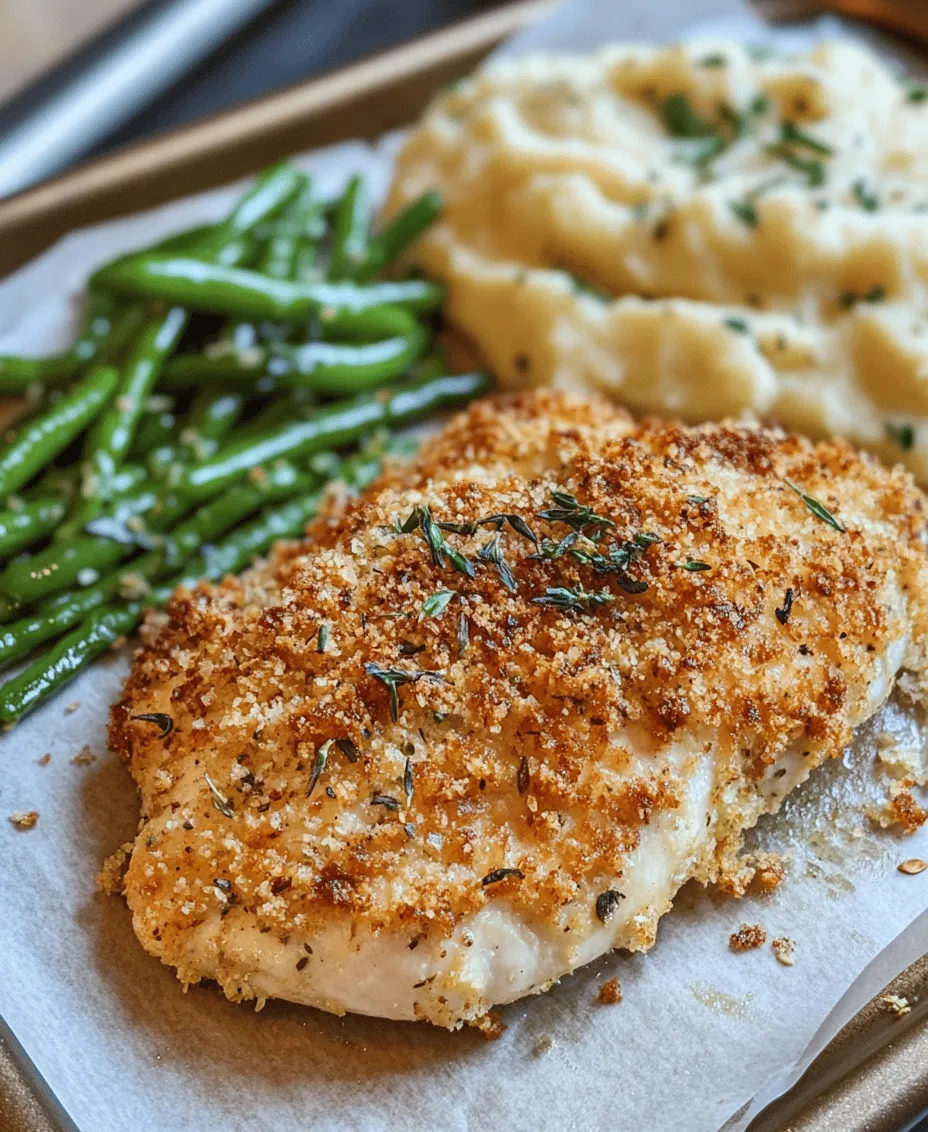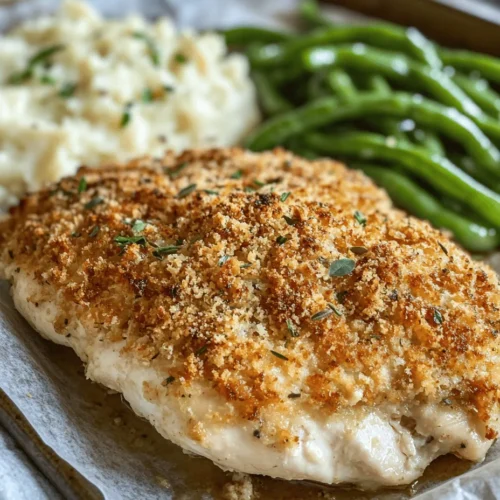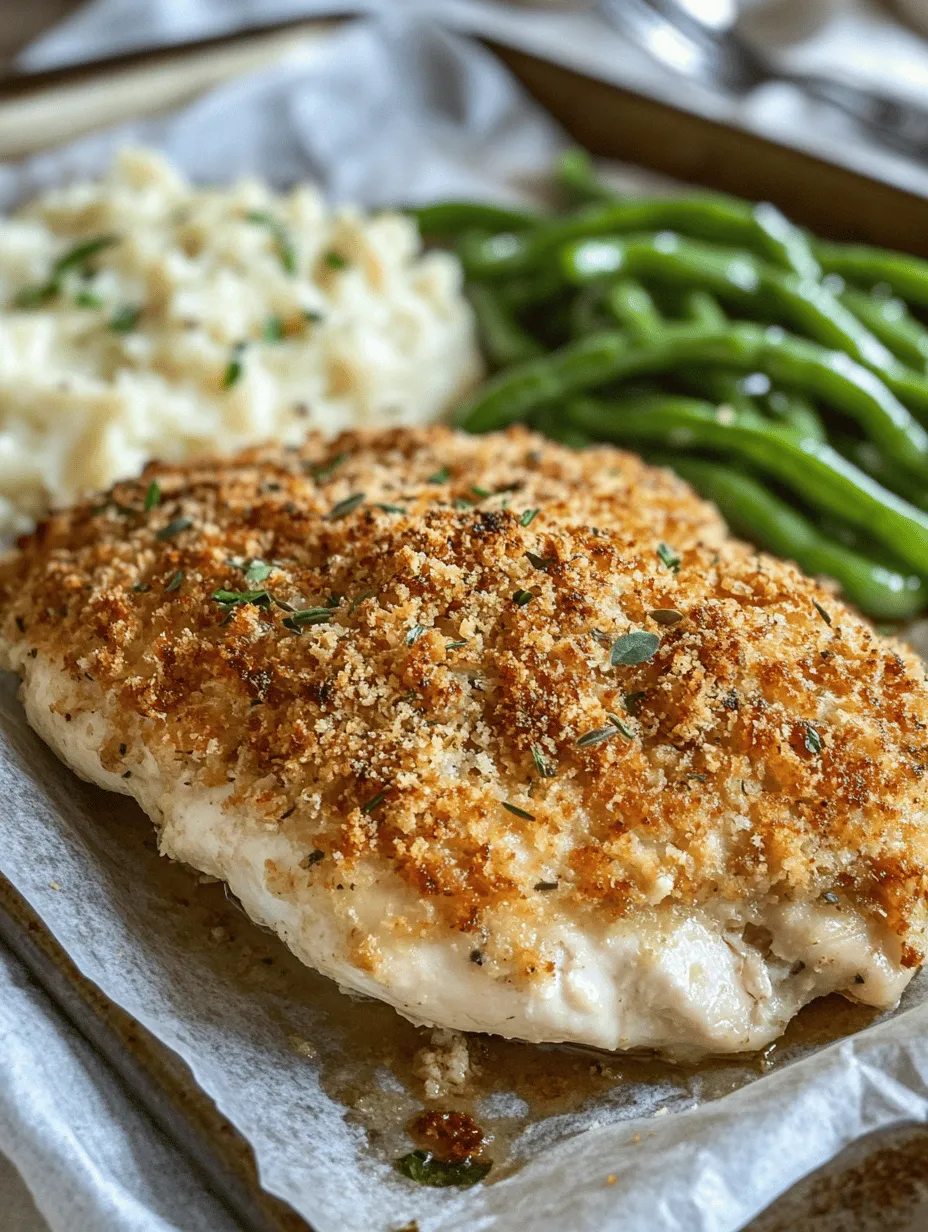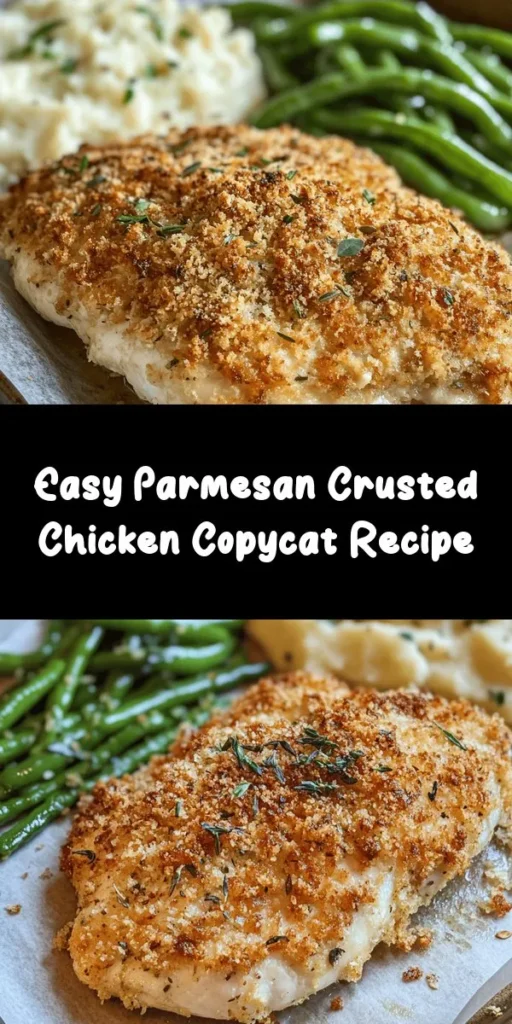Introduction
If you’ve ever dined at Longhorn Steakhouse, you likely remember the mouthwatering taste of their Parmesan Crusted Chicken. This dish has captured the hearts and palates of many, thanks to its crispy, cheesy exterior and juicy chicken breast. The combination of flavors and textures makes it not just a meal, but an experience—one that many diners crave and return for time and again. However, what if you could recreate that same delightful dish in the comfort of your own kitchen?
Recreating restaurant favorites at home is not just a fun culinary challenge; it’s also a way to bring a taste of your favorite dining experience right to your table. With the right ingredients and techniques, you can enjoy the same deliciousness of Longhorn’s Parmesan Crusted Chicken without the wait or the price tag. This easy copycat recipe will guide you through each step, ensuring that your homemade version is as satisfying as the original.
In this article, we will delve into the ingredients that make this dish special and provide you with detailed preparation steps to achieve a perfect result every time. Whether you’re looking to impress guests or simply satisfy your own cravings, this Parmesan Crusted Chicken recipe is sure to become a staple in your home cooking repertoire.
Understanding the Ingredients
To create a dish that rivals the restaurant experience, understanding the role of each ingredient is essential. Each component brings its own unique flavor and texture to the table, contributing to the overall success of the dish.
Chicken Breasts
At the heart of this recipe are boneless, skinless chicken breasts. Choosing quality chicken is crucial, as it serves as the canvas for all the flavors to come. Opt for fresh, organic chicken breasts when possible, as they tend to be more tender and flavorful. The absence of bones and skin allows for quicker cooking and easier eating, making it a perfect choice for this dish.
Parmesan Cheese
Parmesan cheese is the star of the show in this recipe. Its sharp, nutty flavor and granular texture contribute significantly to the crust’s richness. When selecting Parmesan, consider using freshly grated cheese rather than the pre-packaged kind, as this enhances the flavor and ensures better melting and browning during cooking. Authentic Parmigiano-Reggiano cheese is ideal, but any high-quality aged Parmesan will work beautifully.
Breadcrumbs
The choice of breadcrumbs can greatly affect the authenticity of your dish. For an Italian flair, using Italian-style breadcrumbs is recommended. These breadcrumbs are often seasoned with herbs and spices, which add an extra layer of flavor to the crust. If you want to take it a step further, consider making your own breadcrumbs from stale Italian bread to ensure freshness and a personal touch.
Buttermilk
Buttermilk plays a crucial role in marinating and tenderizing the chicken. The acidity in buttermilk helps break down the proteins in the chicken, resulting in a moist and tender final product. Additionally, it enhances the flavor, allowing the spices and herbs to penetrate deeply into the meat. If you don’t have buttermilk on hand, you can easily create a substitute by mixing milk with a tablespoon of vinegar or lemon juice and letting it sit for a few minutes.
Spices and Herbs
To elevate the flavors even further, a blend of spices and herbs is added to the breadcrumb mixture. Garlic powder, onion powder, and a selection of Italian herbs like oregano and basil contribute aromatic notes that complement the cheese and chicken beautifully. Freshly ground spices yield the best flavor, so consider grinding your own if time permits.
Tips on Sourcing Quality Ingredients
For the best results, sourcing high-quality ingredients is key. Visit local markets or specialty stores for fresh chicken and authentic cheeses. Always read labels when purchasing pre-made ingredients like breadcrumbs to ensure there are no unnecessary additives. Fresh herbs can also make a significant difference in flavor, so if you have access to a garden or local farmer’s market, opt for those.
Preparation Steps
Now that we’ve covered the essential ingredients, it’s time to dive into the preparation steps. This section will guide you through the process of getting your chicken ready for the oven, ensuring that each piece is perfectly cooked and coated.
Preparing the Chicken
The first step in preparing your chicken breasts is to ensure they are of even thickness. This is crucial for achieving consistent cooking throughout the meat. Unevenly cut chicken can result in dry, overcooked areas alongside undercooked sections. To achieve uniform thickness, you will need to pound the chicken breasts.
Techniques for Pounding Chicken Breasts Effectively
To pound the chicken breasts, place each piece between two sheets of plastic wrap or parchment paper. This not only prevents mess but also protects your surfaces from raw chicken juices. Using a meat mallet or rolling pin, gently pound the chicken until it is about 1/2 inch thick. Be careful not to pound too hard, as you want to avoid tearing the meat.
Safety Tips for Handling Raw Chicken
When working with raw chicken, it’s essential to practice good food safety habits. Always wash your hands thoroughly before and after handling raw chicken to prevent cross-contamination. Ensure that all surfaces, utensils, and cutting boards used for preparing the chicken are sanitized after contact. If you’re storing any leftover chicken, refrigerate it promptly and never leave it out at room temperature for extended periods.
Setting Up the Breading Station
An organized breading station makes the process efficient and less messy. You’ll need three shallow dishes to set up your breading station: one for the flour, one for the egg mixture, and one for the breadcrumb mixture. This setup allows for a smooth workflow and ensures each piece of chicken is evenly coated.
1. Flour Station: In the first shallow dish, add about a cup of all-purpose flour. Season it lightly with salt and pepper to enhance the flavor of the chicken.
2. Egg Mixture: In the second dish, crack two large eggs and whisk them until the yolks and whites are fully combined. You can add a splash of milk or water to this mixture for a creamier texture.
3. Breadcrumb Mixture: In the third dish, combine the Italian-style breadcrumbs with the freshly grated Parmesan cheese, garlic powder, onion powder, and your choice of Italian herbs. Mix thoroughly to ensure the flavors are evenly distributed.
How to Ensure Even Coating of the Chicken
To achieve an even coating on each chicken breast, follow these steps:
1. Start with the chicken breast, ensuring it is pounded to the correct thickness.
2. Dredge the chicken in the flour, making sure to coat both sides. Shake off any excess flour.
3. Dip the floured chicken into the egg mixture, allowing any excess to drip off.
4. Finally, coat the chicken in the breadcrumb mixture, pressing down gently to ensure an even coating. Make sure every surface is covered to achieve that crispy crust.
Coating the Chicken: Step-by-Step Guide
Once all the chicken breasts are coated, transfer them to a plate or baking sheet lined with parchment paper. This will help catch any crumbs and make cleanup easier. If you have time, let the coated chicken rest for about 15-20 minutes before cooking. This resting period allows the breading to adhere better during cooking, resulting in a crispier texture.
Following these preparation steps will set you up for success as you move on to the cooking process, where the magic of transforming simple ingredients into a delicious meal truly happens. In the next section, we will explore the cooking methods to achieve a perfectly baked Parmesan Crusted Chicken that rivals the restaurant version.
Stay tuned for the continuation of this recipe that promises to deliver a delightful dining experience right from your home kitchen.

Techniques for Dredging and Coating to Achieve the Perfect Crust
To achieve that sought-after crispy crust on your Longhorn Parmesan Crusted Chicken, mastering the dredging and coating technique is essential. Begin with your seasoned flour mixture, which typically includes salt, pepper, and any additional spices you prefer, such as garlic powder or paprika for an extra kick. Dredging involves three main steps:
1. Flour Coating: Start by lightly coating each piece of chicken in the seasoned flour. Ensure each piece is fully covered; this will help the egg wash adhere better.
2. Egg Wash: After the flour, dip the chicken into the egg wash, ensuring it is well-coated. The egg acts as a binding agent, allowing the final coating to stick effectively.
3. Breadcrumb Mixture: Finally, roll the chicken in your breadcrumb mixture. For this recipe, a mixture of panko breadcrumbs and grated Parmesan cheese is ideal for achieving a crunchy texture and rich flavor. Press the crumbs onto the chicken firmly so that they adhere well during baking.
Visual Cues for Knowing When the Chicken is Properly Coated
Proper coating is key to achieving a deliciously crispy crust. After dredging, the chicken should have an even, thick layer of breadcrumbs that covers all sides. The visual cues to look for include:
– Even Coating: The chicken should appear uniformly coated with no spots of exposed flour or egg.
– Thickness: There should be a noticeable layer of breadcrumbs. If the coating appears thin, go back and add more breadcrumbs, pressing them firmly onto the chicken.
– Color: The breadcrumbs should take on a golden hue after baking, indicating that they have crisped up nicely.
Baking the Chicken
Preparing the Baking Sheet: Importance of Parchment Paper and Olive Oil Spray
Before you begin baking, preheat your oven to 400°F (200°C). Line a baking sheet with parchment paper, which not only helps prevent sticking but also ensures easy cleanup. Lightly spray the parchment paper with olive oil or cooking spray. This step is crucial because it contributes to the crispiness of the chicken while preventing it from sticking to the paper.
Baking Process: Timing and Temperature Considerations
Place the coated chicken on the prepared baking sheet, ensuring enough space between each piece for even cooking. Bake the chicken for about 20-25 minutes, flipping it halfway through to achieve an even golden color on both sides. The aim is to create a crispy crust while ensuring the chicken cooks through without drying out.
How to Check for Doneness (Internal Temperature and Visual Cues)
To ensure your chicken is perfectly cooked, use a meat thermometer to check for an internal temperature of 165°F (74°C). Insert the thermometer into the thickest part of the chicken without touching the bone for an accurate reading.
Visual cues are also helpful: the chicken should have a beautiful golden-brown crust, and juices should run clear when pierced with a fork or knife. If you notice any pink juices, the chicken needs additional cooking time.
Importance of Resting the Chicken Before Serving
Once the chicken is done baking, let it rest for about 5 minutes before serving. Resting allows the juices to redistribute throughout the meat, ensuring each bite remains moist and flavorful. This step is often overlooked but is crucial for achieving the best texture and taste.
Serving Suggestions
Ideal Pairings: Complementing the Parmesan Crusted Chicken
Longhorn Parmesan Crusted Chicken is a versatile dish that pairs beautifully with various sides and sauces. Here are some ideal pairings to elevate your meal:
– Garlic Mashed Potatoes: The creamy texture and garlicky flavor of mashed potatoes complement the crispy chicken perfectly, creating a satisfying combination.
– Steamed Green Beans: Fresh, steamed green beans add a pop of color and a healthy crunch to your plate, balancing the richness of the chicken.
– Caesar Salad: A light Caesar salad can serve as a refreshing side, providing a crisp contrast to the warm, savory chicken.
Ideas for Sauces or Dips that Enhance the Dish
To further enhance your Longhorn Parmesan Crusted Chicken, consider serving it with one or more of these delicious dips:
– Marinara Sauce: A rich marinara sauce provides a classic Italian touch, perfect for dipping or drizzling.
– Honey Mustard Sauce: The sweetness of honey mustard pairs wonderfully with the savory chicken, offering a delightful contrast.
– Creamy Ranch Dressing: A cool, creamy ranch dip complements the chicken’s crunch and adds a zesty flavor.
Nutritional Information
Breakdown of Serving Size and Calories
When prepared according to the recipe, each serving of Longhorn Parmesan Crusted Chicken contains approximately 350 calories. This estimate may vary based on the size of the chicken breasts and specific ingredient choices. The recipe typically serves four, making it a great option for family dinners or gatherings.
Discussion of Macro and Micronutrients Present in the Dish
Each serving of this chicken dish provides a good balance of macronutrients, including:
– Protein: Chicken breast is a fantastic source of lean protein, essential for muscle repair and growth.
– Carbohydrates: The breadcrumbs provide a small amount of carbohydrates, necessary for energy.
– Fats: The Parmesan cheese and olive oil contribute healthy fats, supporting overall health.
Additionally, this dish contains micronutrients such as calcium from the cheese and various vitamins from accompanying vegetables, making it a well-rounded meal option.
Variations and Modifications
Options for Dietary Restrictions (Gluten-Free, Dairy-Free)
If you’re looking to modify the recipe for dietary restrictions, there are several alternatives you can consider:
– Gluten-Free: Substitute regular breadcrumbs with gluten-free panko or crushed gluten-free crackers. Ensure that all other ingredients, such as the seasoning mix, are also gluten-free.
– Dairy-Free: For a dairy-free version, you can replace Parmesan cheese with nutritional yeast or a dairy-free cheese alternative.
Creative Twists on the Classic Recipe (Adding Spices, Different Coatings)
Feel free to get creative with your Longhorn Parmesan Crusted Chicken. Here are a few ideas:
– Spicy Kick: Add cayenne pepper or red pepper flakes to the flour mixture for a spicy version.
– Herbed Coating: Incorporate dried herbs, such as Italian seasoning or fresh herbs like parsley, into the breadcrumb mixture for added flavor.
– Nutty Variation: For a different texture, mix crushed nuts (such as almonds or pecans) into the breadcrumb coating for added crunch and flavor.
Conclusion
The Longhorn Parmesan Crusted Chicken recipe is not only delicious but also easy to prepare in the comfort of your home. Its crispy crust and juicy interior make it a dish that appeals to all ages, perfect for family dinners or special occasions.
As you try this recipe, don’t hesitate to experiment with flavors and side dishes to make it your own. The joy of home cooking lies in the ability to recreate restaurant favorites and put your unique spin on them. Whether you stick to the classic version or add your personal touch, this Parmesan Crusted Chicken will surely become a beloved dish in your culinary repertoire. Enjoy the process of cooking and the delight of sharing a homemade meal with your loved ones!



